Antagonistic action of Agrobacterium tumefaciens and essential oils against Aspergillus flavus isolates from Bertholletia excelsa (brasil-nuts).
Antagonistic action of Agrobacterium tumefaciens and essential oils against Aspergillus flavus isolates from Bertholletia excelsa (brasil-nuts).
Author(s): DINIZ, S. P. S. S.; OLIVEIRA, R. C.; KANZAKI, L. I. B.; ROMERO, A. L.; PORTILHO, M.; DIAS, J. do S. A.
Summary: The chestnut-do-brasil (Bertholletia excelsa) is a tree found in the Amazon region, whose fruit called ?the Brazil nut? has an important role in regional economy. Such seeds are affected by the growth of several fungi that produce mycotoxins. The fungus Aspergillus flavus is the main producer of aflatoxins, compromising the nuts. The main objective of this study was study the growth inhibitory action of A. flavus by essential oils of rosemary, anise, beta-caryophyllene, cinnamon, lemongrass, clove, eucalyptus, limonene, mint-citrata and thyme. The culture medium used was the LB, and the incubation was performed at 28°C for 48 hours in the presence of 10μL of the respective oils. Simultaneously, were tested the Agrobacterium tumefaciens and yeasts as possible agents for controlling A. flavus. The results point to a more effective inhibitory activity of essential oils of rosemary, anise, mint-citrata, eucaliptus, lemongrass, thyme, beta-caryophylelene and limonene. Cinnamon and clove oils were unable to inhibit the growth of A. flavus strains. The A. tumefaciens was able to inhibit 16 of 70 A. flavus strains, but is not recorded any inhibition by yeasts.
Publication year: 2012
Types of publication: Abstract in annals or event proceedings
Unit: Embrapa Amapá
Keywords: Castanha, Fungo, Planta nucifera, Semente
Observation
Some of Embrapa's publications are published as ePub files. To read them, use or download one of the following free software options to your computer or mobile device. Android: Google Play Books; IOS: iBooks; Windows and Linux: Calibre.
Access other publications
Access the Agricultural Research Database (BDPA) to consult Embrapa's full library collection and records.
Visit Embrapa Bookstore to purchase books and other publications sold by Embrapa.

